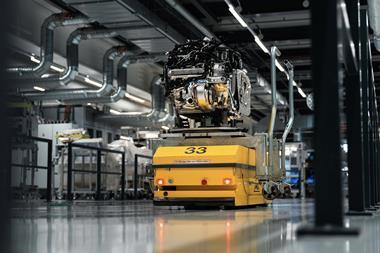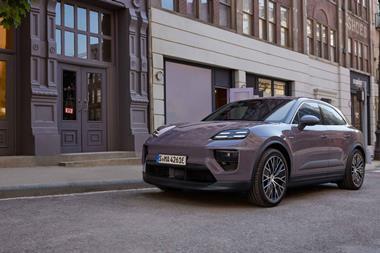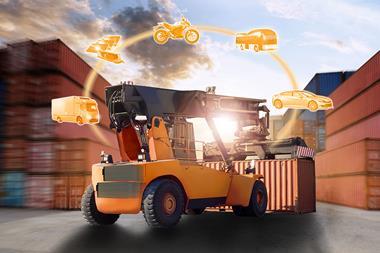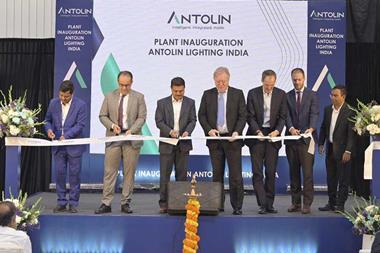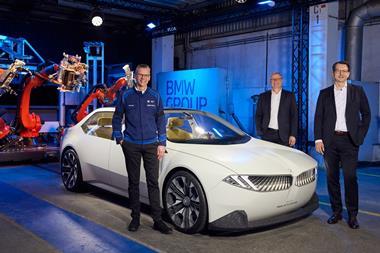The BMW Brilliance Tiexi plant in China is leading the way towards more environmentally friendly paintshops

"The world’s most environmentally friendly paintshop” is currently being ramped up towards full production capacity at BMW Brilliance Tiexi, Shenyang. So says Dirk Gorges, senior vice-president at German supplier of equipment and turnkey paintshops Dürr Systems, which designed and built the facility. It is a claim exemplified by a single performance parameter: the total energy consumed per vehicle for the complete painting process is less than 500kWh.
According to Gorges, that figure is “barely a third” of what would have been the case a decade ago. Perhaps more pertinently, it is also undercuts what he says is the generally accepted benchmark today of around 700-800kWh. But, intriguingly, Gorges explains that this achievement is not the result of any particular innovation in technology – though the installation certainly uses state-of-the-art equipment – but instead the adoption of a new approach to two other issues.
The first of these is a radically different approach to the specification and costing of the facility on the part of the client. The second is the adoption of a highly innovative layout which greatly reduces the overall ‘footprint’ of the installation.
On the first count, Gorges explains that when Dürr was given the contract it was not on the basis of a customary, highly detailed required performance specification. Instead, he says, Dürr was given a document of “little more than a page” which requested them to provide the most sustainable paintshop possible with existing technology and gave them considerable leeway to decide how to achieve that objective. “We saw it as a great chance to put our ideas into practice,” he says.
BMW Brilliance adopted an unorthodox approach to budgeting, having a single unitary cost target rather than two budgets – one for equipment, one for the building. Therefore, what might otherwise have seemed a discouraging premium for the hardware inside the installation could be offset against both reduced capital cost for the building as well as the diminished energy consumption projected for its operation. In consequence, the cost of designing, building and equipping the installation was little different than for a much less energyefficient installation.
Meanwhile, on the second point, Gorges explains that the facility has an unusual layout which features a “nerve centre” for the installation – effectively a single, central storage area for bodies-in-white (BIW) and other assemblies. The importance of this, he states, is that it obviates the need for local storage at other points in the facility, for instance the space that might otherwise be provided near a painting booth to accommodate an assembly if some maintenance to the equipment were suddenly required. In consequence, the whole facility has a significantly reduced floorspace.
As for the actual equipment in the facility, Gorges confirms that there is no single technical innovation acting as a catalyst for the level of efficiency that has been achieved. Indeed, all of the equipment is well-established in Dürr’s product roster.
The initial pre-treatment and electro-coating area, for instance, uses the RoDip M rotational coating system. The actual painting process is based on Dürr’s automated integrated paint process (IPP), a key element of which is the elimination of any need for a primer coat and thus a drying phase.
The spray booths are equipped with Dürr’s EcoDryScrubber dry separation system for overspray, which requires no water or chemicals, while recirculation of the process air results in 60% energy savings in the spray booth. The paint itself is applied using Dürr's EcoRP E033 and EcoRP L133 painting robots equipped with the EcoBell3 rotating atomiser, which enables painting of both BIW exteriors and interiors with the same unit.
While the equipment used in the facility is not necessarily innovative, Gorges points out that what is unusual at the Tiexi facility is the consistent application of best-in-class technology. He says this is not normally the case, for various reasons.
"A complex qualifi cation procedure was devised to train the future workforce of the Tiexi plant and familiarise them with the production processes developed by the BMW Group"– Stefan Riedlinger – BMW
Sometimes the physical structure of the BIW assemblies makes particular procedures difficult, but Gorges adds that OEMs can sometimes ‘freeze’ internal procedural and technical standards for unnecessarily long periods – “five, even ten years” are not atypical. The technology, though, is moving faster than that. Gorges says Dürr’s next target is to achieve an energy consumption level of 300kWh per vehicle and that he expects this figure to be achieved “within three years”.
'The most sustainable plant in China'
BMW is as enthusiastic as Dürr about the levels of efficiency the operation is attaining. Stefan Riedlinger, senior manager paint shop project Tiexi, says: “The Tiexi plant is the most sustainable vehicle production site in China and within the BMW Group’s global production network, the new location ranks amongst the company’s most sustainable plants.” He adds: “All production processes at the plant comply with the BMW Group’s ambitious, globally valid standards with regard to quality, safety and sustainability. The experiences gained within the BMW Group’s global production network were applied both in planning and building the site as well as in establishing suitable production processes and technologies.”
Riedlinger says that a particular strong point of the Tiexi plant is its flexibility. The 336,000m2 accommodate BIW, assembly and logistics, all of which are located in one building. He says that highly qualified staff – ‘associates’ in BMW’s own terminology – plus camera-monitored laser welding procedures and an automation level of 96% help to ensure that maximum quality is reached in the BIW area.
As for the paintshop, Riedlinger says that key facts and performance parameters are as follows:
- Building dimensions: 343mx144mx23m – total floorspace 49,000m2
- No continuous mezzanine building levels. All work and conveyor platforms are located in a way that reduces interfaces between the structure and production equipment. The main automation equipment is located on levels seven and 10 metres
- The manual work decks are located at level 0m, which makes them easily accessible for the personnel involved
- Average throughput time is under ten hours
- System fill is an average of 310 car bodies.
The vehicles painted at the plant, Riedlinger confirms, are currently the BMW X1, 3 Series Sedan and 3 Series Sedan Long Version. He also says that BMW fully recognises that “the major lever in resource conservation in production is the paintshop.” Again, he provides statistics to substantiate that assertion. Compared with press shop, BIW and assembly, he states, the paintshop consumes and generates:
- 41% of total energy
- 35% of total water usage
- 100% of process waste water (treated)
- 100% of solvent emissions (treated)
Riedlinger is adamant that the paintshop in Tiexi is “one of the world’s most sustainable, ‘green’ paintshops”. He confirms Dirk Gorges’ assessment that its use of state-of-the-art technologies and processes means that the principle figures have been reduced to just one third of the average ten years ago.
So how has this been achieved? Riedlinger says that there are three “key enablers” involved.
The first of these is a rotating pre-treatment and electrocoating process. He explains: “In the pre-treatment electro-coat we use a car body rotating conveyor system. Besides enabling a high quality coating result in all cavities it also allows us to reduce the size of the dipping tanks significantly; they are approximately six metres shorter compared with a conventional system. This reduces the amount of chemicals and the energy required for heating and circulation.”
 The second is a dry scrubber system, which Riedlinger describes as an “innovative system for paint overspray separation” which operates without chemicals or water and so differs from the former wet separation process. He says that this leads to a highly efficient recirculation of process air, so that the energy-intensive pre-heating of the air can be avoided. Moreover, the saturated binding material which would be a waste product in a conventional process - in this case limestone - can be reused. In consequence, both wastewater and the energy applied to condition the air are reduced significantly.
The second is a dry scrubber system, which Riedlinger describes as an “innovative system for paint overspray separation” which operates without chemicals or water and so differs from the former wet separation process. He says that this leads to a highly efficient recirculation of process air, so that the energy-intensive pre-heating of the air can be avoided. Moreover, the saturated binding material which would be a waste product in a conventional process - in this case limestone - can be reused. In consequence, both wastewater and the energy applied to condition the air are reduced significantly.
The third is the use of the IPP. Riedlinger claims that the overall procedure is unrivalled in several respects: “It reduces energy consumption, carbon emissions and solvent emissions considerably. It increases productivity by about 40%.”
A major factor in achieving these benchmarks is that the process renders the primer coating unnecessary. Instead, states Riedlinger, it has been replaced by two newly developed basecoats that are applied one after the other in a wet-on-wet process. He explains: “While the first basecoat assumes the protective effect of the primer, the second ensures the visual characteristics with regard to colour, effect and depth. When the two basecoats are covered with a clearcoat, all visual and functional requirements are met.”
Riedlinger also confirms the major contribution made by Dürr. “For the application, 34 latest-generation robots from Dürr are in use,” he states. “The exterior and interior application is done with EcoBell 3 system.” He adds that for all interior and exterior application processes the procedure is 100% electrostatic via the Bell-Bell method. In contrast, second application was previously carried out pneumatically.
Developing key workforce competencies
But technology is not the only factor. Riedlinger says that BMW also paid great attention to developing appropriate competencies amongst the workforce at the plant. “A complex qualification procedure was devised to train the future workforce of the Tiexi plant and familiarise them with the production processes developed by the BMW Group,” he states. “The majority of these specific training sessions took place at the BMW plant in Dadong, which has been implementing the BMW Group’s global standards with regard to quality, safety and sustainability for many years.” He also says that Chinese recruits were trained at BMW’s plants in Munich and Leipzig, as well as at the US plant in Spartanburg, with a focus on enabling them to cope with a higher grade of automation than they might have experienced previously. “For special qualification regarding the integrated painting process, associates were sent for training to Spartanburg, where the second generation of IPP was implemented for the first time in a BMW production network,” he confirms, though he adds that there was also movement in the opposite direction with specialists from Spartanburg sent to Tiexi to share and transfer experience. By the end of this year, with the paintshop ramped up to full production through the addition of a second shift, more than 600 ‘associates’ will be involved.
In conclusion, Riedlinger states that the Tiexi vehicle plant sets new standards for the production of premium automobiles in China and in the BMW Group’s production network. “By combining state-of-the-art technologies in a particularly concerted manner, the site achieves an outstanding level in terms of sustainability,” he states. “At the same time, quality and efficiency of production are optimised thanks to strategic knowledge transfer from other plants.”
Riedlinger adds that a ‘best fit technology’ approach involving standardised procedures guarantees a production level which meets the requirements that also apply at other BMW Group vehicle plants. As such, the paintshop in Tiexi is based completely on the latest BMW reference model for paintshops worldwide, including the implementation of IPP and the dry scrubber system.
Moreover, the future extension of capacity at the paintshop has been considered from the beginning. To this end, Riedlinger confirms that the pre-treatment and electrocoat facilities have been designed to cope with higher capacities. In addition, a building extension of 36m, mainly for a second IPP topcoat line, is also envisaged - though other areas should be capable of expansion within the existing building structure.
























